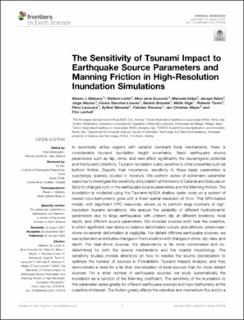The Sensitivity of Tsunami Impact to Earthquake Source Parameters and Manning Friction in High-Resolution Inundation Simulations
Gibbons, Steven John; Lorito, Stefano; de la Asunción, Marc; Volpe, Manuela; Selva, Jacopo; Macías, Jorge; Sánchez-Linares, Carlos; Brizuela, Beatriz; Vöge, Malte; Tonini, Roberto; Lanucara, Piero; Glimsdal, Sylfest; Romano, Fabrizio; Meyer, Jan Christian; Løvholt, Finn
Peer reviewed, Journal article
Published version
Permanent lenke
https://hdl.handle.net/11250/2995132Utgivelsesdato
2022Metadata
Vis full innførselSamlinger
- NGI articles [1061]
Sammendrag
In seismically active regions with variable dominant focal mechanisms, there is considerable tsunami inundation height uncertainty. Basic earthquake source parameters such as dip, strike, and rake affect significantly the tsunamigenic potential and the tsunami directivity. Tsunami inundation is also sensitive to other properties such as bottom friction. Despite their importance, sensitivity to these basic parameters is surprisingly sparsely studied in literature. We perform suites of systematic parameter searches to investigate the sensitivity of inundation at the towns of Catania and Siracusa on Sicily to changes both in the earthquake source parameters and the Manning friction. The inundation is modelled using the Tsunami-HySEA shallow water code on a system of nested topo-bathymetric grids with a finest spatial resolution of 10 m. This GPU-based model, with significant HPC resources, allows us to perform large numbers of high-resolution tsunami simulations. We analyze the variability of different hydrodynamic parameters due to large earthquakes with uniform slip at different locations, focal depth, and different source parameters. We consider sources both near the coastline, in which significant near-shore co-seismic deformation occurs, and offshore, where near-shore co-seismic deformation is negligible. For distant offshore earthquake sources, we see systematic and intuitive changes in the inundation with changes in strike, dip, rake, and depth. For near-shore sources, the dependency is far more complicated and co-determined by both the source mechanisms and the coastal morphology. The sensitivity studies provide directions on how to resolve the source discretization to optimize the number of sources in Probabilistic Tsunami Hazard Analysis, and they demonstrate a need for a far finer discretization of local sources than for more distant sources. For a small number of earthquake sources, we study systematically the inundation as a function of the Manning coefficient. The sensitivity of the inundation to this parameter varies greatly for different earthquake sources and topo-bathymetry at the coastline of interest. The friction greatly affects the velocities and momentum flux and to a lesser but still significant extent the inundation distance from the coastline. An understanding of all these dependencies is needed to better quantify the hazard when source complexity increases.
